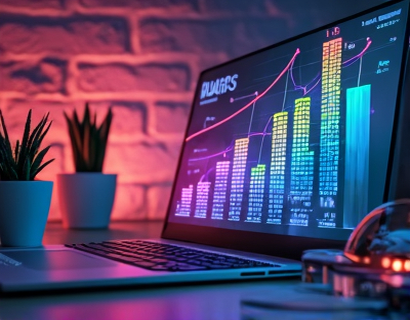AI and Crypto Synergy: Revolutionizing App Solutions for Enhanced Digital Productivity
The intersection of artificial intelligence (AI) and cryptocurrency is giving birth to a new era of digital productivity, where app solutions are being redefined to offer unparalleled efficiency and user experience. This synergy is not just a technological advancement but a transformative shift that is reshaping how we interact with digital tools and services. For tech innovators and early adopters, this convergence presents a unique opportunity to harness the power of both AI and cryptocurrency to create and utilize apps that streamline tasks and boost productivity.
The integration of AI into app solutions has already begun to demonstrate significant benefits. AI algorithms can analyze vast amounts of data to provide insights, automate repetitive tasks, and personalize user experiences. When combined with the decentralized and secure nature of cryptocurrency, the potential for innovation becomes even more profound. This article delves into how this synergy is revolutionizing app solutions, offering a glimpse into the future of digital productivity.
Enhanced Security and Trust
One of the primary advantages of integrating AI and cryptocurrency in app solutions is the enhanced security and trust they provide. Cryptocurrencies, particularly those built on blockchain technology, offer a level of security that traditional systems often lack. The decentralized ledger ensures that transactions are transparent, immutable, and resistant to tampering. When AI is applied to manage and analyze blockchain data, it can further enhance security by detecting and preventing fraudulent activities in real-time.
For instance, AI-powered security systems can monitor blockchain networks for unusual patterns or anomalies, quickly identifying potential threats. This proactive approach to security is crucial in an era where cyber threats are becoming increasingly sophisticated. Users can trust that their data and transactions are secure, which is particularly important for businesses and individuals dealing with sensitive information.
Personalized User Experiences
AI's ability to learn from user behavior and preferences makes it an ideal companion for cryptocurrency-based apps. By analyzing user interactions and transaction patterns, AI can tailor the app experience to individual needs, providing a more personalized and efficient service. This personalization extends to recommendation systems, where AI suggests relevant apps, services, or financial instruments based on the user's historical data and current context.
For example, a cryptocurrency wallet app powered by AI can learn a user's spending habits and investment preferences to offer tailored advice on asset allocation and risk management. This level of personalization not only enhances user satisfaction but also increases the utility of the app, making it a more valuable tool for digital productivity.
Automation and Efficiency
Automation is a cornerstone of AI technology, and when applied to cryptocurrency apps, it can significantly boost efficiency. Smart contracts, self-executing contracts with the terms directly written into code, are a prime example of how AI and cryptocurrency can work together to automate complex processes. These contracts can trigger actions based on predefined conditions, eliminating the need for intermediaries and reducing transaction costs and time.
Consider a scenario where an AI-driven app uses smart contracts to automate cross-border payments. The app can detect when a payment condition is met, execute the transaction on the blockchain, and update the user's wallet in real-time. This seamless process not only speeds up transactions but also reduces the risk of human error and fraud.
Data Analytics and Insights
AI's strength in data analytics is another area where it complements cryptocurrency apps beautifully. The vast amount of data generated by blockchain transactions can be overwhelming to analyze manually. AI algorithms can process and interpret this data to provide actionable insights, helping users and businesses make informed decisions.
For instance, an AI-powered market analysis tool can analyze blockchain data to identify trends, predict price movements, and assess the overall health of the cryptocurrency market. This information can be invaluable for traders and investors, enabling them to optimize their strategies and maximize returns. Additionally, businesses can use these insights to refine their products and services, ensuring they meet market demands.
Decentralized Applications (DApps)
Decentralized applications, or DApps, are a natural fit for the AI-cryptocurrency synergy. DApps leverage blockchain technology to operate on a decentralized network, offering greater transparency, security, and user control. AI can enhance DApps by providing intelligent features that improve functionality and user experience.
For example, an AI-driven DApp for supply chain management can use machine learning to track and predict inventory levels, optimize logistics, and ensure compliance with regulatory requirements. The AI can analyze data from various sources, including sensors and blockchain records, to provide real-time insights and recommendations. This level of intelligence makes DApps more powerful and versatile, driving innovation in various industries.
User Interface and Experience (UI/UX)
The integration of AI and cryptocurrency is not only about backend processes but also about enhancing the user interface and experience. AI can be used to design intuitive and user-friendly interfaces that adapt to individual preferences and behaviors. This adaptive UI/UX ensures that users can navigate and utilize app features with minimal friction, even for those who are less tech-savvy.
For instance, an AI-powered cryptocurrency trading app can analyze a user's interaction patterns and adjust the interface to highlight the most used features. It can also provide real-time assistance through chatbots or virtual assistants, guiding users through complex tasks and answering queries instantly. This combination of AI and cryptocurrency creates a seamless and enjoyable user experience, encouraging greater adoption and engagement.
Challenges and Considerations
While the synergy between AI and cryptocurrency offers numerous benefits, it also comes with its own set of challenges. One of the primary concerns is the regulatory landscape. Cryptocurrencies are still a relatively new and evolving space, with regulations varying widely across different jurisdictions. AI systems must be designed to comply with these regulations, which can be complex and time-consuming.
Another challenge is the technical complexity involved in integrating AI with blockchain technology. Developers need to have a deep understanding of both domains to create robust and efficient solutions. Additionally, the scalability of AI-driven apps on blockchain networks is a critical consideration, as blockchain can sometimes be limited in terms of transaction throughput and processing speed.
Future Prospects
The future of AI and cryptocurrency synergy in app solutions is promising. As technology continues to advance, we can expect to see more sophisticated and integrated applications that leverage the strengths of both AI and blockchain. The development of more efficient consensus mechanisms, improved AI algorithms, and enhanced user interface technologies will further drive this synergy forward.
Moreover, the growing adoption of decentralized finance (DeFi) and non-fungible tokens (NFTs) is creating new opportunities for AI-driven apps. These emerging trends are pushing the boundaries of what is possible, from decentralized lending and borrowing platforms to unique digital assets with intelligent properties. AI can play a crucial role in managing and optimizing these complex systems, ensuring they operate smoothly and securely.
In conclusion, the convergence of AI and cryptocurrency is revolutionizing app solutions, offering enhanced security, personalized experiences, automation, and valuable insights. For tech innovators and early adopters, this synergy presents a wealth of opportunities to create and utilize apps that streamline tasks and boost digital productivity. As the technology evolves, the potential for innovation and transformation in the digital landscape is immense.











































